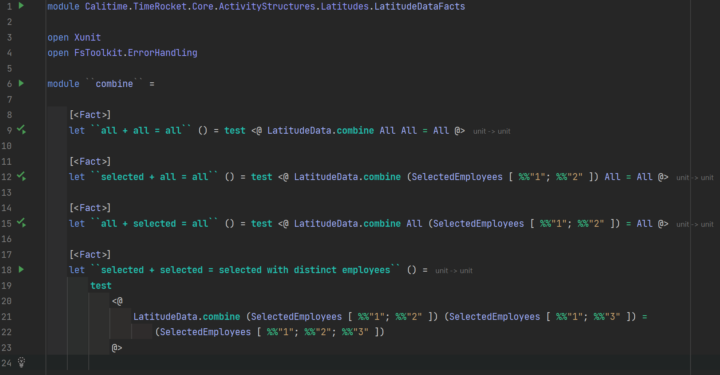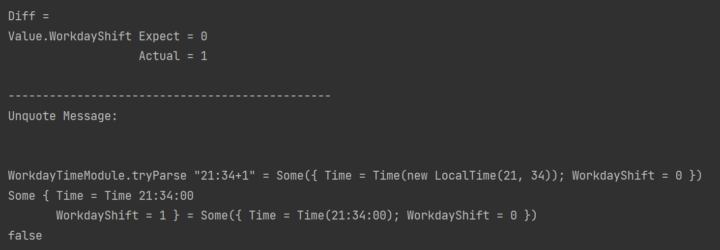
Sometimes, unit tests are really small – so small that they fit on a single line:

When comparing complex data types in unit test assertions, for example, records with nested lists containing discriminated unions, the error messages quickly get hard to understand. How to spot a single difference?
That’s why I mixed Unquote and D-Edge.Diffract together.
An example unit test from our codebase:
If you are familiar with hamcrest and JUnit the time will come when you have the need to create your own matchers. Creating your own matcher can be as simple as useful. One reason for creating your own matcher could be that your object is not a default object like a String or a Collection. And if you would like to get a more readable version of the assert for the next developer who has to read your test. Let’s make an example. If you have an object with two methods; “getName”...
Do you program or do you already TDD? 🙂
If you prefer to do TDD you will love the eclipse plug-in called MoreUnit. It is as simple as powerful. All it does is executing tests from corresponding productive class and makes it very simple to change between them.
Just press Ctrl-J (like Jump) to jump from test to implementing class and the other way. Or press Ctrl-R (like Run) to run the test regardless if you are in the test or the implementation class.
Updated: new version here! I have compiled two cheat sheets about clean code (the ones mentioned in my post about Code Quality!). The first covers clean code – code that is easy readable and keeps changeable. The second is about Test Driven Development. Both cheat sheets list principles, patterns, practices and smells. You can download them here – Clean Code Cheat Sheet V1.3, Clean TDD Cheat Sheet V1.2. Take a look! I’d like to read your feedback in the comments section… (just an...
To continue my series on Mocking Katas (see Mocking Kata – Instrument Processor for the last Kata), I’ll show you a very simple Kata that I normally use in my Test Driven Development training courses to introduce mocks (created manually or dynamically with the use of a mocking framework): the CharacterCopier.
We use Coding Katas in Coding Dojos to improve our programming skills. This includes skills in software design, refactoring, Test Driven Development, Mocking, tool usage and a lot of other tiny stuff. However, I found only a few Katas, especially Katas including the need for mocks (see for example ). Most Katas are very algorithmic, which is good for learning TDD. But its bad for learning how to use mocks. Therefore, I started to invent my own Mocking Katas. I use these in my training courses...
The Model View View-Model pattern gained a lot of momentum lately. It allows to reduce the code in the code behind class of a form or user control to a minimum. Therefore, unit testability is improved dramatically compared to other view patterns like MVC/MVP. However, when I design software, I follow (amongst others) the principles of SOLID (link). The first principle in SOLID is the Single Responsibility Prinicple (SRP) that states that “A class should have one, and only one, reason to...
NMock2 is a library for assisting test driven development of .NET code by providing a dynamic mock object creation framework. In this article, I’m going to show you the basics of the new stub feature in NMock2. Note that this feature is currently only available on the development trunk in the subversion repository at . Therefore, the features discussed here may change for the next official release. Stubs can be used in scenarios where you have to test an instance of a class (let’s call this...
Andrew Kazyrevich published a post containing timing comparisons of Moq, Rhino Mocks, Isolator and NMock2.
And NMock2 – although still lacking some features – is very fast compared to the competitors. Woohoo!
I’m curious how the newly introduced features (mock classes, non-strict and recursive mocks) will change in this setup. I’ll check that out as soon as I find some time :-O
If you want to check the new features (alpha!) yourself then here is the svn URL:
Happy mocking!